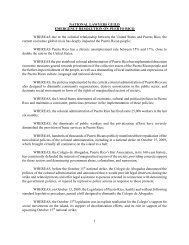NLGRev 68-2[1].indd - National Lawyers Guild
NLGRev 68-2[1].indd - National Lawyers Guild
NLGRev 68-2[1].indd - National Lawyers Guild
You also want an ePaper? Increase the reach of your titles
YUMPU automatically turns print PDFs into web optimized ePapers that Google loves.
96 national lawyers guild review<br />
the law came into force in 1999 to 1,500 in 2002. 243 By 2004 the recruitment<br />
of women into street prostitution had almost halted. 244 With a population of<br />
9 million, Sweden is estimated to have only 500 street prostitutes, while<br />
neighboring Denmark, with a population just over half that size, had between<br />
5,500 and 7,800 in 2004, half of whom, it is estimated, were victims of trafficking.<br />
245 In contrast, a five-year evaluation of the German law shows that<br />
it has neither improved conditions for women in the prostitution industry<br />
nor helped women to leave. It has also failed “to reduce crime in the world<br />
of prostitution.” 246 The reported results are that “prostitution should not be<br />
considered to be a reasonable means for securing one’s living.” 247<br />
Supporters of the Swedish law say it has also had an impact on trafficking<br />
into Sweden, with the <strong>National</strong> Criminal Investigation Department (NCID)<br />
reporting that the country is no longer an attractive market for foreign gangs. 248<br />
Intercepted telephone conversations show that pimps and traffickers express<br />
frustration about setting up shop in Sweden, preferring to operate in Denmark,<br />
Germany, the Netherlands, and Spain. In its 2004 report the NCID concluded<br />
that the law “continues to function as a barrier against the establishment of<br />
traffickers in Sweden”; it estimates that roughly 400–600 women are trafficked<br />
into Sweden each year, compared with between 10,000 and 15,000<br />
into Finland. 249 The law’s opponents claim it has made street prostitution<br />
more risky because the few remaining clients tend to be more “perverted,”<br />
but most of them concede that it has reduced demand. 250<br />
Norway adopted the model in 2009 and has seen a 20 percent decrease<br />
in street prostitution, 16 percent in indoor prostitution and a 60 percent decrease<br />
in advertisements for sexual activities. 251 It appears that the Swedish<br />
approach is a strong, viable method to ending exploitation and prostitution of<br />
women. The Swedish government’s premier vision has inspired the international<br />
community, including the CEDAW Committee, to begin to recognize<br />
that prostitution is not some inevitable societal fixture, but is driven by the<br />
patriarchal expectation of males to have sexual access to females on demand.<br />
The success of the Swedish approach clearly shows the way forward for<br />
implementation of Article 6.<br />
States must address patriarchy in social relationships<br />
Accepting the myth that men possess uncontrollable sexual urges and that<br />
prostitution is a way to prevent men from raping innocent women is seen as<br />
the ultimate justification for prostitution. 252 The Whore/Madonna dichotomy<br />
then continues; some women can be raped, others cannot. As scholars Vednita<br />
Carter and Evelina Giobbe state, “Prostitution exists in and is maintained<br />
by a male-controlled society where violence against women and children is


![NLGRev 68-2[1].indd - National Lawyers Guild](https://img.yumpu.com/30820772/34/500x640/nlgrev-68-21indd-national-lawyers-guild.jpg)













